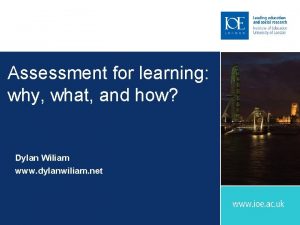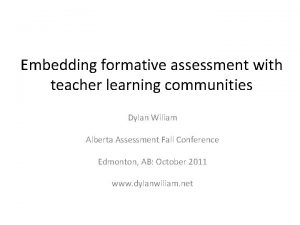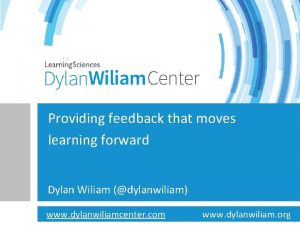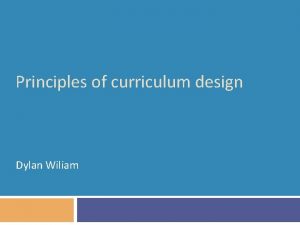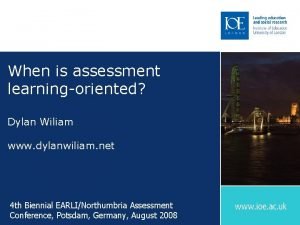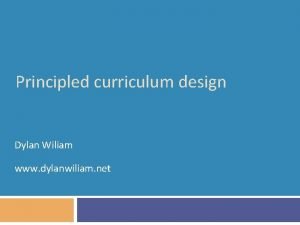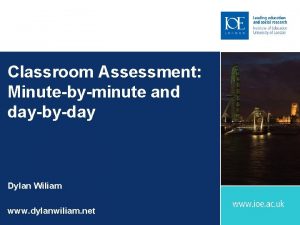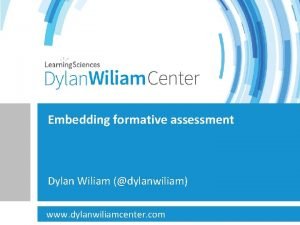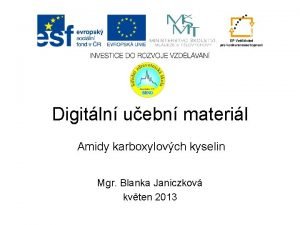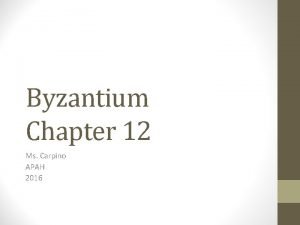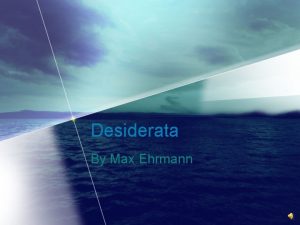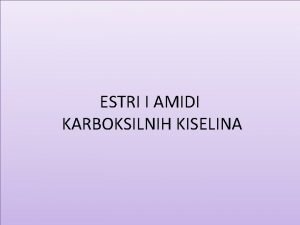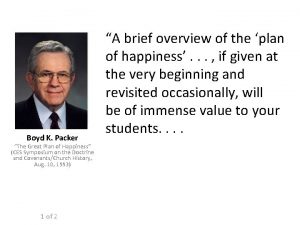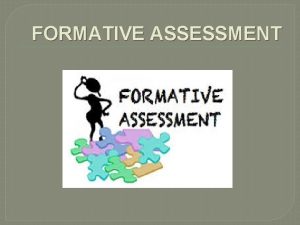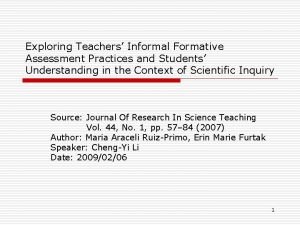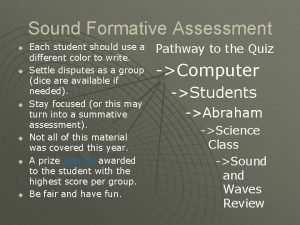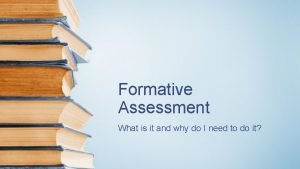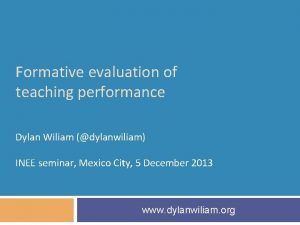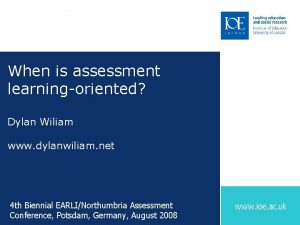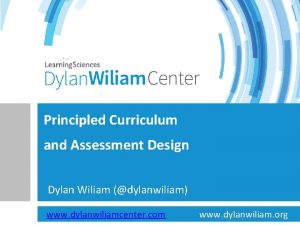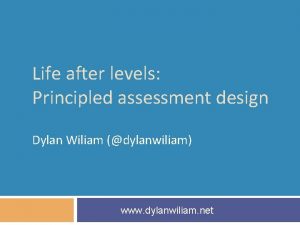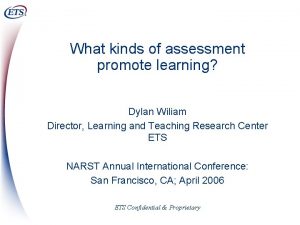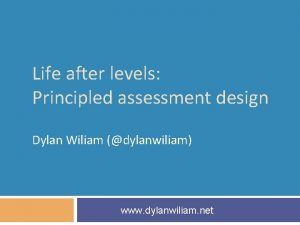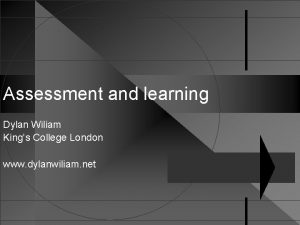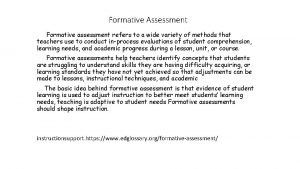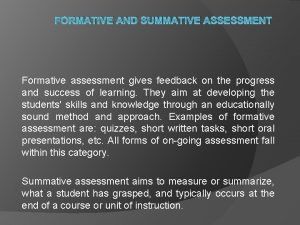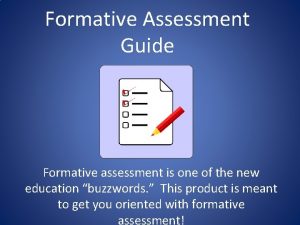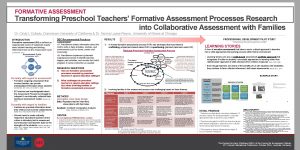Formative assessment amid uncertainty Dylan Wiliam dylanwiliam www




















- Slides: 20

Formative assessment amid uncertainty Dylan Wiliam (@dylanwiliam) www. dylanwiliamcenter. com www. dylanwiliam. org

Effective learning environments 2 • A prevalent, mistaken, view – Teachers create learning – The teacher’s job is to do the learning for the learner • A not so prevalent, not quite so mistaken, but equally dangerous view – Only learners can create learning – The teacher’s job is to “facilitate” learning • A difficult to negotiate, middle path – Teaching as engineering effective learning environments that: • Create student engagement (pedagogies of engagement) • Are well-regulated (pedagogies of contingency) • Develop disciplinary habits of mind (pedagogies of formation)

Why formative assessment? 3 • A principle and an uncomfortable fact about the world – The principle: • "If I had to reduce all of educational psychology to just one principle, I would say this: The most important single factor influencing learning is what the learner already knows. Ascertain this and teach him [or her] accordingly” (Ausubel, 1968 p. vi) – The uncomfortable fact: • Students do not learn what we teach.

Learners do not (always) learn what we teach… 4 Denvir and Brown (1986)

Why formative assessment? 5 • A principle and an uncomfortable fact about the world – The principle: • "If I had to reduce all of educational psychology to just one principle, I would say this: The most important single factor influencing learning is what the learner already knows. Ascertain this and teach him [or her] accordingly” (Ausubel, 1968 p. vi) – The uncomfortable fact: • Students do not learn what we teach. – What is learning? • Learning is a change in long-term memory (Kirschner et al. , 2006) • The fact that someone can do something now does not mean they will be able to do it in six weeks, but • If they cannot do something now, it is highly unlikely they will be able to do it in six weeks

6 How memory works

Why teaching is really hard 7 1. Performance (how well a learner completes a learning task) and learning (the changes in longterm memory that result) are different 2. Learning and performance are negatively correlated 3. Students do not reliably know when they are learning 4. Students do not reliably know whether they know something

The psychology of learning (Thorndike, 1913) 8 • “The Law of Exercise comprises the laws of Use and Disuse. ” (p. 2) – “The Law of Use is : When a modifiable connection is made between a situation and a response, that connection's strength is, other things being equal, increased. ” (p. 2) – “The Law of Disuse is : When a modifiable connection is not made between a situation and a response during a length of time, that connection's strength is decreased. ” (p. 4)

“The new theory of disuse” 9 • An item in memory is characterized by – Storage strength • how well learned an item is • can only increase – Retrieval strength • how easy an item is to retrieve at a particular time • goes up and down Bjork (1992)

How memory really works 10 • Storage strength and retrieval strength are increased by – Re-studying an item – Retrieving it from memory – Retrieval has a greater impact than re-study Bjork (1992)

Studying and testing 11 • 180 students read one of two TOEFL passages: “The Sun” (256 words) or “Sea Otters” (275 words) • Each passage contained 30 idea units • Phase 1: four 7 -minute periods, interspersed with 2 minute multiplications problems • Students randomly allocated to one of three patterns of study (S) and testing (T) – SSSS – SSST – STTT • Students then tested on their recall of the passages immediately (i. e. , after 5 minutes) and after 1 week

Studying and testing Proportion recalled Five minutes 90% 80% 70% 60% 50% 40% 30% 20% 10% 0% SSSS Roediger and Karpicke (2006) One week SSST Study pattern STTT

How memory really works 13 • Storage strength and retrieval strength are increased by – Re-studying an item – Retrieving it from memory – Retrieval has a greater impact than re-study • Retrieval and re-study increase: – storage strength more when retrieval strength is low – retrieval strength more when • retrieval strength is low • storage strength is high Bjork (1992)

Interleaved mathematics practice • 54 7 th grade classes taught by 15 teachers in 5 middle schools in a large school district in Florida • Classes described as “advanced honors mathematics” • All recruited teachers taught at least two sections • Students completed a total of 9 worksheets over a four month period, followed by a test one month later • Each worksheet covered two sides of a sheet of paper and contained 8 problems Rohrer, Dedrick, Hartwig, and Cheung (2019)

Four kinds of problem A. Graphs B. Inequalities C. Expressions D. Circles

Experimental design Worksheet Review Test Interleaved practice 10 days Blocked practice 103 days 35 days

Participants School A B C D E Teacher Interleaved classes Blocked classes 1 2 2 2 3 2 2 4 1 1 5 1 1 6 1 1 7 2 2 8 2 2 9 3 2 10 2 1 11 2 2 12 1 1 13 2 2 14 3 3 15 2 2

Test results Blocked Interleaved Mean 38 61 Standard deviation 27 29 Effect size (Cohen’s d) Percentile increase Rohrer, Dedrick, Hartwig, and Cheung (2019) 0. 83 30

What does all this mean? 19 • Use assessment at the beginning of a lesson/topic – Provide retrieval practice – Activate prior knowledge • Design instruction that minimizes cognitive load – Extrinsic load: minimized through good instructional design (avoid distractions) – Intrinsic load: minimized through good curriculum sequencing (distributed practice) • Don’t assume that performance equals learning – Zero-stakes testing – Question generation

20 Thank You www. dylanwiliam. net
 Dylan wiliam formative assessment
Dylan wiliam formative assessment Dylan wiliam teacher learning communities
Dylan wiliam teacher learning communities Feedback dylan wiliam
Feedback dylan wiliam Tlc dylan wiliam
Tlc dylan wiliam Dylan wiliam curriculum design
Dylan wiliam curriculum design Dylan wiliam learning intentions
Dylan wiliam learning intentions Dylan williams skills
Dylan williams skills Tlc dylan wiliam
Tlc dylan wiliam What is the aera
What is the aera Amid kyseliny benzoové
Amid kyseliny benzoové Ester tipi lokal anestezikler
Ester tipi lokal anestezikler Virgin and child between saints theodore and george
Virgin and child between saints theodore and george Desiderata by max
Desiderata by max амонолиза
амонолиза The great plan of happiness
The great plan of happiness Amid this hot green glowing gloom
Amid this hot green glowing gloom Hamlet dramski sukob
Hamlet dramski sukob Formativa
Formativa Informal formative assessment
Informal formative assessment Formative assessment
Formative assessment Formative assessment
Formative assessment
